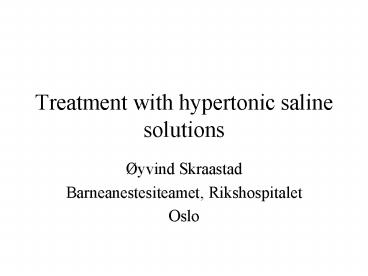Treatment with hypertonic saline solutions - PowerPoint PPT Presentation
1 / 35
Title:
Treatment with hypertonic saline solutions
Description:
20 years of research and clinical trials. Hypertonic ... Transcapillary fluid transport. ions. proteins. Starling -balance. Pkap. Pint. NF = K( Pkap -Pint ... – PowerPoint PPT presentation
Number of Views:427
Avg rating:3.0/5.0
Title: Treatment with hypertonic saline solutions
1
Treatment with hypertonic saline solutions
- Øyvind Skraastad
- Barneanestesiteamet, Rikshospitalet
- Oslo
2
20 years of research and clinical trials
- Hypertonic saline,7.5 NaCl (HS)
- Hypertonic saline/ 6 dextrane 70 (HSD)
- Hypertonic saline/ 6 HES 200/0.5 (HSS)
3
Hypertonic saline
- Small volume - 4ml/kg
- Infusion in peripheral veins - no phlebitis
observed - Colloids added (dextrane,starch) improves
volume-expansion - duration - Acute hypovolemia and shock
- Mobilisation of extravasal fluid
4
Hypertonic saline- experimental data and clinical
trials
- Experimental studies
- acute bleeding
- sepsis, burns
- increased intracranial pressure
- Clinical studies
- acute traumatology
- intraoperative hypovolemia, cardiac surgery
5
Cardiac output
HSD Dextrane HS No volume resuscitation
Bleeding
Bolus inf.
hypotension
after infusion
baseline
minutes
Smith -89
6
To be preferred in volume resucitation
- Hypertonic saline solutions should be
- Effective
- Increased intravascular volume, increased cardiac
output - Duration of effect
- Reduced mortality/morbidity
- Side effects/adverse effects negliable
- Price
7
Transcapillary fluid transport
Pkap?
Starling -balance
NF K( Pkap -Pint ?int -?kap)
?int?
Pint?
P kap Intravascular hydrostatisk pressure P
int Extravasc hydrostatisk pressure ? kap
Intravascular colloid osmotisk pressure ? int
Intravasc. colloid osmotisk pressure
?kap?
ions
proteins
8
Physiological effects
- Transcapillary Osmotic forces Increased
plasma volume
1 mOsm excerts osmotisk pressure of 19,3 mmHg
Capillary leakage reduce the effect of
hypertonic saline, but still Absorbtive
force of 50 -200 mmHg (Colloids 2-4 mmHg)
9
Osmotic transcapillary fluid transport
- Osmotic effects depends on
- permeability for each solute in different
capillary beds - number of particles on each side of the membrane
- Osmotic effects by
- few, large molecules with low permeability
- many, small particles with higher permeability
10
Effects of hypertonic saline solutions
- Intravasation of fluid from extravascular space
- Peripheral vasodilatation
- Increased cardiac contractility
- Increased cardiac index
11
Other effects
- Increased diuresis
- Reduced intracranail pressure
- Reduced endothelial edema, Reduced precapillary
resistance and increased microcirculation - Immunology ? (leucocyte adhesion, mediators of
inflammation )
12
Future of hypertonic saline solutions
- Effective fluid resucitation - rapid
intravascular rehydration - Fluid drug to reduce extravascular fluid in
hypervolemia - After cardiac surgery
- Intracranial hypertension
13
Plasma volum increase
ml ekspansion ml infusion
Kramer et al. -89
Time
14
Dilution by 4ml/kg HSDHealthy volunteers
? Plasmavol 7,6 ml/kg
Hb (g/100 ml)
? Plasmavol 9,7 ml/kg
HSD
Time (min)
Tølløfsrud et al.-98
15
Distribution of fluid HSD 4 ml/kg(140ml)
minutter
Tølløfsrud et al. -00
16
Distribution of fluid Ringer 25ml/kg (929 ml)
Tølløfsrud et al. -00
17
Relative intravascular volume
HSD 4 ml/kg
ml expansion ml infusion
Ringer 25 ml/kg
Infusion
Tid (min)
Tølløfsrud et al.-00
18
Relative volume-expansion-effect of HSD/Ringer
VEE ratio of HSD/Ringer
infusion
Time (min)
Tølløfsrud et al.-00
19
Acute traumatology
- Effect in patients with multitrauma incl head
trauma - Reduced need for infusions
- Reduced need for transfusions
- No significant hypernatremia, coagulopathy
- But hyperchloremia
20
Cardiac surgery Ex.corp circulation and capillary
leakage
Ex.vasc.space
Cell
Ringer
Blood
Lymph
Leakage 11-30 ml/min during ex.corp circulation
Koller et al. 1992 Fluid
overload at end op. 5,2 l Tølløfsrud
et al 1995
21
- Fontanpatient with fluid overload.
22
Diuresis and heart surgery
ml
Inf
Tølløfsrud et al. -98
23
Fluid balance and heart surgery
ml
Infusion
Tølløfsrud et al. -98
24
Hemodynamic data
CI
Inf.
Tølløfsrud et al. -98
25
Open heart surgery
- Increased CI postoperatively
- Reduced SVR
- Reduced fluid overload after surgery
- But - increased preload - heart failure
- NB !Doses of fluid and rate of infusion
26
Intracranial hypertension
- Continously high sodium values (145-160 mmol/l)
may reduce elevated ICP when conventional
treatment fails - Reduce transcapillary leak in pathological brain
tissue (trauma, tumor, ischemia) ? - Reduce extravascular fluid in areas with normal
blood-brain-barrier
27
Clinical use of hypertonic saline solutions
- Optimal dose ?
- Optimal rate of infusion ?
- Dose bolus 4 ml/kg 5-20 minutes.
- NB !
- Volume sensitive patients
- vasodilatation
- changes in Na- concentration
28
Conclusion
- Safe and effective treatment of hypovolemia
- Effective treatment of extravascular fluid
overload ? - Beneficial for patients with elevated ICP ?
29
(No Transcript)
30
(No Transcript)
31
(No Transcript)
32
(No Transcript)
33
(No Transcript)
34
(No Transcript)
35
(No Transcript)































